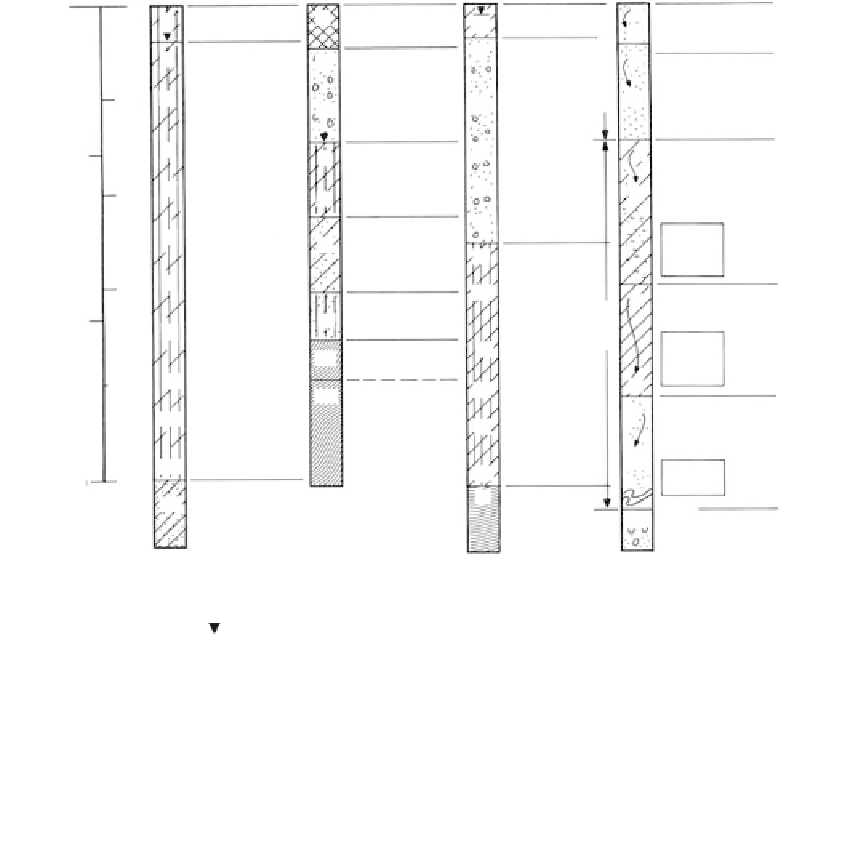Environmental Engineering Reference
In-Depth Information
Depth
mft
b. Philadelphia,
Pennsylvania
c. Wilmington,
Delaware
d. Richmond,
Virginia
a. Keyport,
New Jersey
N
N
N
N
9
21
10
Yellow-brown
sandy clay
Yellow to red
to gray clays
and sands
"Sand and
gravel,
some clay"
Yellow-brown
clay and silt
10
Miscellaneous
rubble fill
18
12
25
Yellow-brown
gravelly sand
with gravel beds
and silt
lenses
18
Dark gray
silty clay,
occasional
sand seams
(Cretaceous
clays)
60
Brown silty
sandy gravel
100
20
30
40
70
38
51
4
Greenish-gray
clayey fine
sand with pockets
plastics clay
10
7
Gray silty
clay
38
24
40
14
20
67
LL = 60
PI = 40
w
n
= 40
46
Orange clayey
silty sand
25
Red-brown,
yellow, gray
variagated
silty clay
interbedded
with sand
layers
44
68
60
103
"Greenish-gray
clay"
7
Yellow-green
silty sand
Decomposed
mica schist
Sound mica
schist
20
30
LL = 90
PI = 60
w
n
= 60
30
100
73
80
22
12
30
80%
Gray to dark
gray clayey
silty sand
79
44
60
91
LL = 35
PI = 20
178
55
30
100
Decomposed
gneiss
120
Gray clayey
silty sand
120 ft
100
Sand and gravel
150 Granite
147
150
(a)
(b)
(c)
(d)
Legend: N = Standard penetration test values
= Groundwater table
% = Percent core recovery
LL = Liquid limit, %
PI = Plasticity index
w
n
= Natural water content, %
FIGURE 7.53
Logs of test borings made in Atlantic coastal plain deposits. (Parts a-c courtesy of Joseph S. Ward and
Associates; part d after Casagrande, L.,
Proc. ASCE, J. Soil Mech. Found. Eng. Div
., Sept., 106-126, 1966.)
swelling (see
Section 10.6.2).
The location and extent of the most active clay soils in Texas
are given in
Figure 7.54.
Typical properties are as follows (from Meyer and Lytton, 1966):
•
Description: Tan and gray clay (CH); very stiff, jointed, and slickensided; black
discoloration along the joints; clay type, montmorillonite
•
Index properties:
w
13 to 30%; LL
40 to 0%; PL
17 to 25%; PI
25 to 70%; bar
linear shrinkage from LL
12 to 25%; percent passing no. 200 sieve, 70 to 100%
•
Strength:
U
c
2.0 to 8.0 tsf; failure usually occurs along joints
•
Swell pressure at zero volume change: 2.0 to 11.0 tsf
•
Volume change at 1 psi (0.7 tsf) confining pressure: 5 to 20%
Los Angeles Coastal Plain
General
The heavily preconsolidated marine clays of Tertiary age evident along the coast north and
south of Los Angeles are of particular interest because of their instability in slopes and


